Registered with the Registrar of Newspapers for India under R.N.I 53640/91
Vol. XXXI No. 14, November 1-15, 2021
Delhi’s ‘Madrasi’ school set to complete 100 years
by M.R. Narayan Swamy
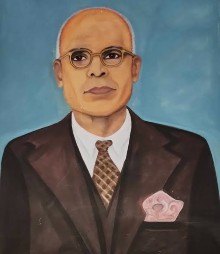
P.H. Sundaresa Iyer, the founder-teacher of DTEA.
There could not have been a more modest birth. Who would have imagined that a school with just one student and one teacher in a small room would eventually blossom into one of the best schools in the Indian capital, producing exemplary academic results year after year! Welcome to the Delhi Tamil Education Society (DTEA) which will soon complete 100 glorious years.
Ex-students and retired teachers, who lived through the times when studying in DTEA was considered a matter of pride, still recall their school years with a sparkle in their eyes. Some became emotional as they remember the struggling years when the school operated in tents; at that time, no one was sure if DTEA would succeed. But success did come, in part due to divine blessings and in part due to the dedication of the school’s founders, teachers and a Tamil community that valued quality education more than anything else in life.
When it was born in Simla on Vijaya Dasami day in 1923, DTEA was known as the Madrasi Education Association (MEA).MEA became DTEA half-a-century later.
The 1930s was when Tamils began settling down in Delhi in steadily increasing numbers to serve the British bureaucracy. Armed with a knowledge of English, typing and shorthand skills, most Tamils held lower rung posts though some were perched in the middle level. The community had a single concern: how to educate their children in a place far away from their hometowns without losing touch with Tamil?
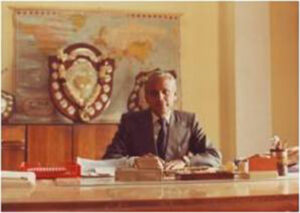
S. Natarjan.
The MEA founder was P.H. Sundaresa Iyer, who was known for his immaculate English and stylish western clothing. Interestingly, for someone who laid the foundation for what became a hugely successful school, PHS, as he was known, had only passed Class X. But he was a visionary. The Tamil community respected him. After registering the MEA in 1919, he set up in1923 a primary school which soon shifted to Delhi, eventually finding its way to its present location on Mandir Marg (then Reading Road) in the heart of the capital. For two decades, PHS shuttled between Delhi and Simla (the British Raj would shift en bloc with the officialdom to Simla every summer). Teachers were recruited and more and more students were enrolled.
Until Independence in 1947, only the Mandir Marg MEA School existed. A second school came up in 1951 at Lodi Estate and the third the next year at Karol Bagh (Pusa Road). Once Independence dawned, the Tamil community in Delhi began to swell. Most lived in central and south Delhi to be close to their government offices – the reason the schools came up in this swathe of the city. New branches were founded in Lakshmi Bai Nagar in 1958, in Moti Bagh in 1961 and in R.K. Puram the next year. An existing Tamil school in Janakpuri was taken over in 1975, three years after the MEA changed its name to DTEA when Tamil Nadu Chief Minister M. Karunanidhi made it a condition in lieu of a one-time grant. It was only in 2020 that the 8th school was opened in Mayur Vihar.
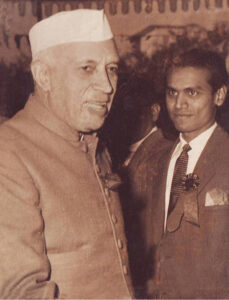
S. Natarajan, one of the most accomplished and respected Principals of MEA/
DTEA schools with Prime Minister Jawaharlal Nehru when he came to inaugurate
Lakshmi Bai Nagar school.
The first school was set up with small voluntary contributions from the mostly middle-class community. The first higher secondary classes (Class 9 to 11) began in 1946 and the first batch of higher secondary students passed out in 1949. All the schools began as primary or middle school; it was only later that the higher secondary wing was added. The school had one single motto: study, study, study.
“I believed in strict discipline but with dignity and decorum,” recalls S. Natarajan, one of the most successful Principals to serve MEA/DTEA until 1991. “I did not believe in declaring a child failed. To me, it is a sad reflection on the school if a child is not motivated even to merely scrape through the annual exam.”
A man widely seen as an architect of MEA/DTEA schools was K. Suryanarayanan, who was also a decorated Principal. Hailing from Madurai, it was he who introduced the school uniform and started terminal exams for all the branches. He also introduced inter-school transfers and began the practice of having Saraswati puja in every school to bless senior students on their farewell day. The Indian government picked Suryanarayanan for the National Teachers Award. In the same year, the Delhi government chose him for the State Award – a rare but well deserved dual honour.
If Principals like Natarajan and Suryanarayanan succeeded in their mission, it was due to the quality brought in by the teachers, male and female, who produced students who went on to become successful doctors, charted accountants, lawyers, bankers, business executives, business leaders, teachers, architects, journalists, scientists, IT wizards, airline executives, government employees (at all levels), military personnel… The list is endless. Erstwhile star and Bollywood ‘Dream Girl’ Hema Malini is from DTEA. Many students settled down abroad with plum jobs.
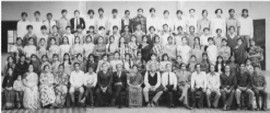 Outgoing Class 11 Group Photo of DTEA Lakshmi Bai Nagar branch, |
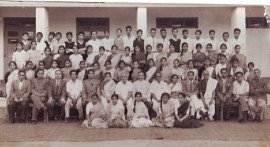 MEA Lodi Estate school leaving batch Science students 1959-60. |
All the three Principals, V. Subramanian, T. Rajagopalan and N.M. Rajaram, played a stellar role in the growth of DTEA. It will be near impossible to list all the teachers who served with distinction, winning the hearts of students and parents alike. Despite the many administrative responsibilities they had, DTEA Principals also took classes and were indeed masters of the subjects they taught. If Natarajan was a doyen of English, Rajagopalan and Rajaram taught Mathematics and Chemistry respectively with passion. While an overwhelming number of teachers were Tamil, there was no parochialism. Many north Indians served MEA/DTEA with unquestioned diligence and loyalty, a handful of them – including N.K. Sharma, who later became the Principal of one of the schools – learning and speaking Tamil fluently! Some teachers authored text books which the CBSE prescribed for schools across Delhi.
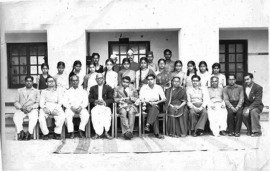
Staff members sitting Left to Right: K.Ramasubramanian, K.V. Haraharakrish-
nan, S.Yegneswaran, V. Swaminatha Iyer, David Gnaniah, S. Natarajan, Jaya
Venkataraman, Makhan Lal Jan, A.P. Narayanaswami Iyer, S. Ramakrishnan,
Tej Kiran Jain.
Standing Top Row – Third from Left is Tulsi Ram – Senior most Class IV staff
who joined the MEA from the days PHS Iyer started the school.
No account of DTEA will be complete without mentioning M. Visalakshi, who was popularly known as “Chitti Teacher”. She joined MEA when she was just 18 and went on to teach generations of children in Class 1 (there was no KG or nursery then) for – believe it or not – 40 long years! She had a unique way of teaching. She was always armed with a small stick but she loved the five-year-olds as if each of them was her own child. The Delhi government – which funds DTEA – not only conferred the Best Teacher award which included a citation and cash on her just before she retired but gave her a two-year extension in service.
P. Srinivasan, whose father S. Padmanabhan was one of the founder members of the Janakpuri school, recalls his days with nostalgia. “I remember we even swept and mopped the school floor daily in the (initial) absence of a peon. We did not mind, and our parents were not hurt seeing us do so-called menial work.” The Tamil community started the Janakpuri school in 1973 with just two students at the late Padmanabhan’s house after he and his family moved to a rented accommodation. A second flat was rented out in 1974 to accommodate more students. Eventually, in 1975, DTEA took over the school.
Barring a handful, no teacher believed in corporal punishment. Of course boys known for erratic conduct had to be disciplined. Occasionally, someone was asked to stand on the bench or outside the classroom for a while. A single whack with a scale was viewed as a major punishment. One or two teachers ordered “thoppukarnam”! Every student knew that he or she would have it if the teachers ever complained to their parents.
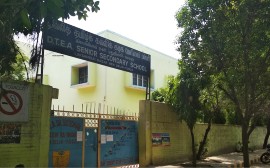 DTEA School Laxmi Nagar branch. |
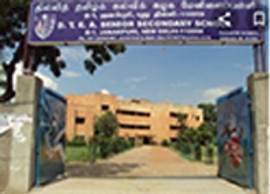 DTEA School Janakpuri branch. |
Right from MEA days, the school had a rule: No Tamil speaking family will be denied admission at any time of the year. This was unique to MEA/DTEA schools. The idea was that government servants got transferred all the time and no child should suffer on this account. On top of it, the school had a very different – and one could say convenient – timing: 10 am to 4 pm. Thanks to this, no student was flogged to wake up at sunrise! And till the mid-1950s, MEA was the only south Indian school in the capital.
Tamil was taught right from Class 1. Hindi was a subject from Class 2. As long as school ended with Class 11, students had the option to opt for either Tamil or Hindi from Class 9. The medium of instruction was English. Teachers made it a rule that students should speak only in English while learning English. Although it raised eyebrows then, ex-students feel it was this insistence that made a huge difference in their personality growth, enabling DTEA products to successfully take on their counterparts from the better known and richer public schools.
Considering the quality education that was provided, education in MEA/DTEA was virtually free in view of the meagre fees. No tuition fee could be levied till Class 8. This was a massive relief to Tamil families who were mostly cash strapped in the 1940s, 50s and 60s as they had just one bread winner but had two, three or more children to be educated. Donations were not accepted though, of course, the community chipped in regularly with contributions big and small. Cultural and musical events were staged to raise money. Souvenirs were brought out for advertisement revenue. Legends in music and arts – M.S. Subbalakshmi,Lalgudi Jayaraman and S.P. Balasubramanian (to name only a handful of the many) – gave concerts for DTEA. Even embassies in Delhi were courted. It is with money collected painstakingly in this manner that the school buildings and other infrastructure including well-stocked libraries came up one after the other, doing away with the tents and ‘dhuries’.When the schools functioned under tents, an impromptu holiday would be declared whenever it rained!
If C. Rajagoplachari opened the Mandir Marg school in 1946, Madras Chief Minister K. Kamaraj inaugurated the new school building at Lodi Road in 1955. Prime Minister Jawaharlal Nehru laid the foundation stone at Lakshmi Bai Nagar in 1960. Madras Chief Minister M. Bhaktavatsalam laid the foundation stone at Karol Bagh in 1963 and the school was inaugurated six years later by Tamil Nadu Chief Minister M. Karunanidhi. When Prime Minister Indira Gandhi attended a DTEA event at Lodi Road, she invited the legendary P.H. Sundaresa Iyer to come to the stage. It was only then people learnt that PHS had taught Tamil to Indira Gandhi at Teen Murti Bhavan.
The Lodi Road school houses a beautiful marble idol of Gooddess Saraswathi. On Vijaya Dasami day, Saraswathi puja was held every year in all the branches. Before the school leaving examination, the Lodi Road students’ Hall Ticketswould be placed before the Saraswathi idol and handed back after a devotional prayer, with the blessings of the Principal and the teachers.
MEA/DTEA was more than a school. In reality, the schools were an extension of a student’s family. Every cultural and religious value one believed at home was also practiced in the school. During holidays, the school buildings hosted cultural and religious events. Ramanavami would see katha tellers from Tamil Nadu regale eager audiences comprising of parents and students. Groups like South Indian Samaj regularly held functions which often ended with students, parents and teachers sitting in winding rows, partaking tamarind, coconut and curd rice.


Pingback: Delhi’s ‘Madrasi’ school set to complete 100 years – II « Madras Musings | We Care for Madras that is Chennai